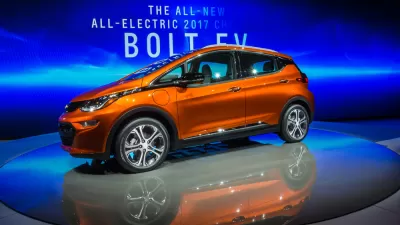With Toyota's long-waited fuel cell electric vehicle (FCV) hitting showrooms in the U.S. this week, Kenneth Chang, science reporter for The New York Times, delves further into the technology, starting with how it fared under two administrations.
"President George W. Bush espoused the environmental promise of cars running on hydrogen," writes Chang. [See our 2003 post]. However, under "Steven Chu, the Nobel Prize-winning physicist who was President Obama’s first Secretary of Energy, (t)he administration slashed funding for hydrogen fuel cell research."
While "(a)ttention shifted to battery electric vehicles, particularly those made by the headline-grabbing Tesla Motors [see related post about Chu's technology priorities], General Motors, Honda, Toyota, Daimler and Hyundai, persisted," writes Chang. "After many years and billions of dollars of research and development, hydrogen cars are headed to the showrooms."
Hyundai has been leasing the hydrogen-powered Tucson sport utility, which it describes as the world’s first mass-produced fuel cell car, since June, for a $2,999 down payment, and $499 a month. (That includes the hydrogen.)
"This week, Toyota is introducing a sedan called Mirai, which means 'future' in Japanese," writes Chang. "The Mirai will go on sale in California this year for $57,500 — cheaper than the Tesla Model S." Test drive the Mirai - on You-Tube.
“It’s a no-brainer that I think the next evolution is to go to fuel-cell based technologies,” said Nihar Patel, the vice president for North American business strategy at Toyota.
The world's largest automaker and manufacturer of the iconic hybrid vehicle, the Prius, is by no means abandoning conventional electric vehicles. "Toyota officials talk of selling a 'portfolio' of vehicles that includes hybrids and battery electric cars. But hydrogen fuel cells are front and center," adds Chang.
California is a popular place for auto companies to market FCVs because of their investment in hydrogen fueling infrastructure funded by the passage last year of AB 8.
Not all are on board, least of all those most invested exclusively in plug-in electric vehicles. Last word goes to the most well-known critic, but do consider reading a related article from Quartz about his reaction.
Elon Musk, the billionaire chief executive of Tesla, mocks fuel cells as “fool cells” that will lose in the marketplace to battery electric cars like his. Battery electrics are more efficient than fuel cells and are cheaper to operate. And there are currently many more places to plug in than places to top off a tank of hydrogen.
FULL STORY: A Road Test of Alternative Fuel Visions

Planetizen Federal Action Tracker
A weekly monitor of how Trump’s orders and actions are impacting planners and planning in America.

Congressman Proposes Bill to Rename DC Metro “Trump Train”
The Make Autorail Great Again Act would withhold federal funding to the system until the Washington Metropolitan Area Transit Authority (WMATA), rebrands as the Washington Metropolitan Authority for Greater Access (WMAGA).

The Simple Legislative Tool Transforming Vacant Downtowns
In California, Michigan and Georgia, an easy win is bringing dollars — and delight — back to city centers.

The States Losing Rural Delivery Rooms at an Alarming Pace
In some states, as few as 9% of rural hospitals still deliver babies. As a result, rising pre-term births, no adequate pre-term care and "harrowing" close calls are a growing reality.

The Small South Asian Republic Going all in on EVs
Thanks to one simple policy change less than five years ago, 65% of new cars in this Himalayan country are now electric.

DC Backpedals on Bike Lane Protection, Swaps Barriers for Paint
Citing aesthetic concerns, the city is removing the concrete barriers and flexposts that once separated Arizona Avenue cyclists from motor vehicles.
Urban Design for Planners 1: Software Tools
This six-course series explores essential urban design concepts using open source software and equips planners with the tools they need to participate fully in the urban design process.
Planning for Universal Design
Learn the tools for implementing Universal Design in planning regulations.
Smith Gee Studio
City of Charlotte
City of Camden Redevelopment Agency
City of Astoria
Transportation Research & Education Center (TREC) at Portland State University
US High Speed Rail Association
City of Camden Redevelopment Agency
Municipality of Princeton (NJ)



























